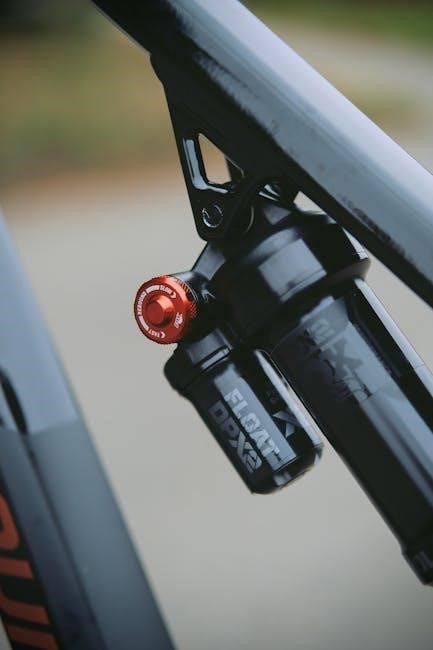Choosing the right bike frame size is crucial for comfort, performance, and safety. This guide helps you understand key measurements like standover height and inseam to ensure a proper fit.
Importance of Proper Bike Fit
A proper bike fit is essential for comfort, efficiency, and safety while cycling. A well-fitted bike ensures optimal pedaling efficiency, better control, and reduces the risk of discomfort or injury. Incorrect frame size can lead to issues like back pain, knee pain, or difficulty maneuvering the bike. A bike that is too small or too large can hinder performance and make cycling less enjoyable. Proper fit also enhances safety, as it allows for better handling and the ability to stop effectively. Investing time in finding the right size ensures a more enjoyable and injury-free cycling experience. Always prioritize a proper fit to maximize comfort and performance.
How to Measure Yourself
Measure your height, inseam, and reach to determine the ideal bike frame size. Standover height and inseam are critical for ensuring comfort and proper fit.
Height Measurement
Height measurement is a fundamental step in determining your bike frame size. Stand barefoot with your feet together and measure from the top of your head to the floor. This measurement helps estimate your ideal frame size, as taller riders typically require larger frames. However, height alone isn’t enough, as body proportions vary. For example, two riders of the same height may have different inseam lengths, affecting their standover clearance. Road bikes often use metric measurements, while mountain bikes use inches. Always refer to the specific bike type’s sizing chart to match your height to the correct frame size. Your height provides a baseline, but inseam and reach measurements refine the fit.
Inseam Measurement

Inseam measurement is critical for determining your standover height and bike frame size. To measure your inseam, stand barefoot and place a book or similar object against your crotch. Measure vertically from the floor to the top of the book. This length determines your standover clearance, ensuring safety and comfort. For road bikes, aim for 1-3 inches of clearance, while mountain bikes may require slightly more. Inseam is often more important than height, as it directly affects your ability to stand over the bike comfortably. Use this measurement alongside your height to find the ideal frame size, ensuring proper fit and riding efficiency. Always consult the specific bike type’s sizing chart for accurate results.

Bike Frame Measurement
Bike frame size is determined by measuring the seat tube length in centimeters for road bikes or inches for mountain bikes, ensuring proper fit and performance.
Standover Height
Standover height is the distance from the ground to the midpoint of the bike’s top tube. It ensures there’s enough clearance between the rider and the frame for safety. Proper standover height allows riders to dismount quickly without discomfort or injury. For road bikes, 1-3 inches of clearance is ideal, while mountain bikes typically require 2-4 inches. This measurement is crucial for maintaining control and preventing accidents, especially in sudden stops. Always measure standover height accurately to ensure a safe and comfortable riding experience.
Frame Size
Frame size is determined by measuring the length of the seat tube, which varies by bike type. Road bikes are sized in centimeters, while mountain bikes use inches. Proper frame size ensures optimal comfort, efficiency, and control. A bike that’s too small may cause discomfort, while one that’s too large can be difficult to handle. Always consult the manufacturer’s size chart for accuracy, as sizing can vary between brands and models. Professional fitting is recommended for precise adjustments, and a test ride is essential to confirm the fit. Correct frame size is vital for maximizing performance and reducing the risk of injury, ensuring a safe and enjoyable cycling experience.
Bike Types and Sizing
Bike sizing varies by type, with road bikes measured in centimeters, mountain bikes in inches, and hybrids offering versatile fits. Always consult the manufacturer’s specific size guide.
Road Bikes
Road bikes are sized based on frame measurements in centimeters, catering to riders seeking speed and efficiency. Standover height is critical, requiring 1-3 inches of clearance for safety and comfort. Proper fit ensures optimal performance, with handlebar reach and saddle height tailored to the rider’s proportions. Professional bike fitting is recommended to fine-tune adjustments for maximum comfort and efficiency. Always consult the manufacturer’s size chart for accurate frame sizing, as variations exist between brands. Test riding is essential to confirm the right fit, ensuring a seamless cycling experience.
Mountain Bikes
Mountain bikes are sized differently than road bikes, with frame sizes typically measured in inches. Standover height is crucial for safety, requiring 2-4 inches of clearance to avoid discomfort or injury. Proper fit ensures better control and handling on rough terrain. Unlike road bikes, mountain bike sizing focuses on stability and maneuverability. Consult the manufacturer’s size chart, as frame sizes vary by brand and model. Test riding is essential to confirm comfort and performance. A well-fitting mountain bike enhances off-road experiences, providing confidence and precision on trails. Always consider professional fitting for optimal adjustments, ensuring a seamless and enjoyable ride.
Hybrid Bikes

Hybrid bikes combine elements of road and mountain bikes, offering versatility for various riding conditions. Frame sizes are typically measured in centimeters or inches, depending on the manufacturer. Standover height is essential for comfort and safety, with recommended clearance similar to mountain bikes. Proper fit ensures efficient pedaling and handling. Hybrid bikes often feature a more upright riding position, reducing strain on the back and shoulders. When choosing a size, consider both height and inseam measurements. Test rides are crucial to ensure the bike feels comfortable and responsive. A well-fitting hybrid bike provides a balanced experience for commuting, recreational rides, or light off-road adventures, making it a practical choice for many cyclists.
Manufacturer-Specific Sizing
Manufacturer-specific sizing varies significantly across brands, as each may use different measurement systems or frame geometries. Some brands offer detailed size charts tailored to their bike models, while others may use standard sizing. It’s essential to consult the specific manufacturer’s guide for accurate measurements, as frame sizes can differ even within the same bike type. For example, one brand’s medium size might be another’s large. Some manufacturers also provide tools or calculators to determine the ideal frame size based on your height and inseam. Always refer to the product page or official documentation for precise sizing information to ensure a proper fit and optimal performance for your chosen bike.
Gender-Specific Bikes
Gender-specific bikes cater to anatomical differences, with women’s bikes often featuring shorter torsos and longer legs compared to men’s models. These bikes typically have narrower handlebars, shorter stems, and women-specific saddles for comfort. However, sizing remains individualized, and some riders may find unisex frames more suitable. Factors like reach and standover height are critical, regardless of gender. Always test ride to ensure the best fit, as personal preference and body proportions vary widely. While women-specific bikes aim to enhance comfort and performance, they aren’t universally necessary, and the right frame size should be determined by personal measurements and riding style.

Kids’ Bike Sizing
Kids’ bike sizing focuses on height and inseam to ensure safety and comfort. Avoid buying bikes with room to grow; proper fit is crucial for control and confidence. Most bikes are sized by wheel diameter, ranging from 12 to 26 inches, corresponding to age and height ranges. Standover height should allow at least 1-2 inches of clearance for safety. Test rides are essential to confirm fit, ensuring your child can maneuver safely. Always prioritize current fit over future growth to prevent accidents and ensure an enjoyable riding experience for your child.

Professional Bike Fitting
A professional bike fitting ensures optimal performance and comfort by tailoring the bike to your body. Experts analyze your riding style, flexibility, and physical measurements to adjust components like saddle height, handlebars, and pedal alignment. This process minimizes the risk of injury and enhances efficiency, making it a worthwhile investment for serious cyclists.
While proper frame size is foundational, a professional fitting fine-tunes every detail. It’s particularly beneficial for those with specific needs, such as riders with chronic pain or those seeking peak performance; Many bike shops offer fitting services, often included with new bike purchases, ensuring your ride is customized for maximum comfort and efficiency.

Test Ride and Final Check
A test ride is essential to confirm the bike’s fit and feel. It allows you to assess comfort, handling, and overall performance in real conditions. During the ride, pay attention to how you feel—whether your posture is comfortable, your reach to the handlebars is natural, and your legs can pedal efficiently without strain.
After the ride, ensure all adjustments are made to optimize your position. A final check by a professional can verify that the bike is set up correctly, addressing any issues before you commit to the purchase. This step ensures your new bike provides years of enjoyable and safe riding experiences.


Common Mistakes to Avoid
One of the most common mistakes is buying a bike based on looks rather than fit. Many riders overlook proper measurements and rely on general sizing charts, which can lead to discomfort or safety issues. Additionally, some riders assume that a bike will “break in” over time, but an ill-fitting frame cannot be adjusted to compensate for poor sizing. Another mistake is not considering the standover height, which is critical for safety and comfort. Riders should also avoid relying solely on age or gender-specific recommendations. Always prioritize personal measurements and test rides to ensure the best fit. These oversights can lead to discomfort, inefficiency, or even injury, making it crucial to approach bike sizing methodically and carefully. Proper fit is essential for an enjoyable cycling experience, so take the time to get it right. By avoiding these pitfalls, you can ensure your bike is both comfortable and safe to ride. This attention to detail will enhance your overall cycling experience and prevent potential issues down the road. Ultimately, a well-fitted bike is an investment in your health and enjoyment of the sport.

Choosing the right bike frame size is essential for a safe, comfortable, and enjoyable cycling experience. Proper fit ensures optimal performance and reduces the risk of injury. Always prioritize accurate measurements, including standover height and inseam, and consult manufacturer-specific charts for your bike type. Avoid common mistakes like buying based on appearance or assuming a bike will “fit” over time. Test rides and professional fittings can further refine your bike’s setup. By following these guidelines, you’ll find a bike that aligns with your body and riding style, making every ride more enjoyable and efficient. Remember, the right fit is an investment in your cycling journey.



0 Comments